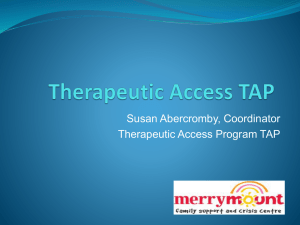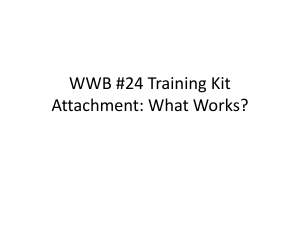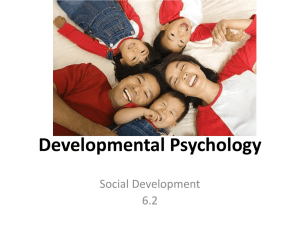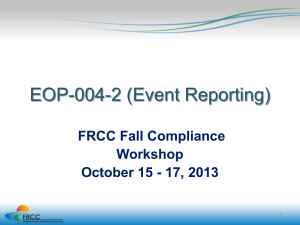SLIDES - Managing the Disruptive Patient
advertisement
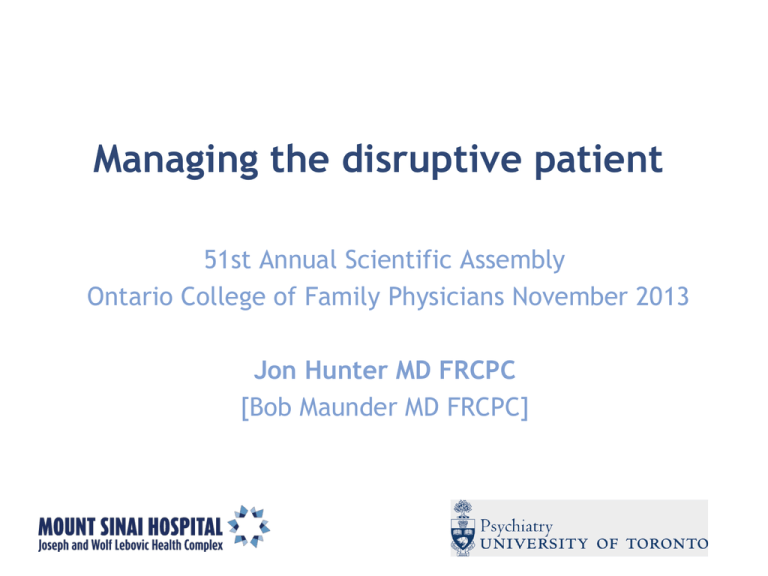
Managing the disruptive patient 51st Annual Scientific Assembly Ontario College of Family Physicians November 2013 Jon Hunter MD FRCPC [Bob Maunder MD FRCPC] Faculty/Presenter Disclosure • Faculty: Jon Hunter • Program: 51st Annual Scientific Assembly • Relationships with commercial interests: – NONE Disclosure of Commercial Support • This program has received NO financial support • This program has received NO in-kind support • Potential for conflict(s) of interest: – NONE Mitigating Potential Bias • N/A Objectives 1) participants will be able to recognize attachment styles 2) participants will learn how the attachment style of an individual influences their interaction with HCW’s 3) participants will derive techniques for managing disruptive attachment behaviors Sarah Difficult Call from FP unit: • “Jon, you’ve got to help me with Sarah…she calls all day, overwhelming the secretary, and demands lots of attention, about all these flaky symptoms… when she’s here she’s so loud she’s putting other patients off…She seems to hate my suggestions, but when I try and end the appt. she’s hard to get out of the unit...I’m ready to strangle her…” Literature Review N = 500 outpatients -- 15% rated as difficult More likely to have: • • • • • • • Mental disorder > 5 somatic symptoms > severe symptom Poorer function More unmet expectations Less satisfaction with care Higher use of services Hahn, Kroenke,J. of Gen Int Med 1996 Jackson,Kroenke, Archives Int Med 1999 Literature Review • 21 patients described by 9 FP’s as ‘difficult’ • 7/21 difficult patients vs.1/21 controls had (at least one) personality disorder • 5/21 had dependent (‘wimpy’) personality Schafer, Nowlis Archives Fam Med 1998 Literature Review • Interview of 15 randomly sampled FP.’s in Israel • >5 years in practice • Structured I/V + Questionnaire… Steinmetz, Tabenkin, Family Practice, 2001 Literature Review • • • • • • • • Difficult Patient: ‘Everything hurts’ High anxiety ‘Pain in the neck’ Demanding, exploiting Angry at doctor Uncooperative Difficult psychiatric patient Drug Addict Literature Review • James E Groves • Taking Care of the Hateful Patient • New England Journal of Medicine, 1978 • Hateful patients… “induce feelings which their caregivers find difficult to tolerate” Attachment and disruptive behavior… • How does understanding attachment style help you with Sarah Difficult? • Let’s classify her: Preoccupied/anxious attachment: • I find that others are reluctant to get as close as I would like. I often worry that my partner doesn’t really love me or won’t want to stay with me. I want to merge completely with another person, and this desire sometimes scares people away. Dismissing attachment: • I am somewhat uncomfortable being close to others; I find it difficult to trust them, difficult to allow myself to depend on them. I am nervous when anyone gets too close, and often, [love] partners want me to be more intimate than I feel comfortable being. Disorganized/fearful attachment: • I am constantly frustrated by partners, I feel the need to be really close, but then they screw me over, and I get so angry I blow up. They can’t understand me, and when they back off, I get really scared of being alone, but even angrier that they’re leaving.... The attachment system… Explore until it’s dangerous Stay close until it’s safe Dimension of Attachment Avoidance Fearful or Disorganized Dismissing Preoccupied Secure Dimension of Attachment Anxiety University of Toronto Consultation-Liaison Psychiatry Division Adult attachment styles: • • • • Secure (55%) Anxious (Compulsively care-seeking) (20%) Dismissive (Compulsively self-reliant) (15%) Disorganized (Fearful) (10%) Why you see insecure people as patients: “we have a baby, . . . someone close to us departs or dies, a limb is lost or sight fails” Bowlby J. Attachment and Loss, Vol. 1: Attachment. New York: Basic Books, 1969 , pg. 82 Why you see insecure people as patients: Tertile of attachment insecurity → “trying to make myself feel better by eating, smoking, drinking, using drugs or medications” low middle high 8% 8% 33% (Maunder, Lancee, Balderson et al., 2006) What changes with different A/S’s? 1) Healthcare Utilization Mean Annual Primary Care Costs (US$) (Ciechanowski, 2000): Primary Care Costs in 701 People with Diabetes 550 500 450 400 350 300 Secure Preoccupied Dismissing Interpersonal Style Fearful Proportion of medical patients who report symptoms that What changes with different A/S’s? cannot be explained 2) proportion of unexplained symptoms 80 Percentage 60 40 20 0 Secure Preoccupied Dismissing Fearful Anxious attachment: • Preoccupied with fear • Can’t cope by self, need to keep other attached via constant distress signal • Experienced as needy, or clingy Anxious attachment Management guidelines: • HCW as External Modulator of patient • Attentive, supportive attitude • Preemptive contact to decrease “distress signals” • Frequent, regular, time-limited contact: - not contingent on distress Anxious attachment Management guidelines: • Present team as an integrated whole • Enhance internal regulation of distress: – reminders of previous coping – relaxation techniques – benzodiazepines (ie night before and morning of chemo.) A post-operative phone call & pain p < .001 18 16 14 12 10 8 phone call no call p < .001 6 4 2 0 Pain score # pain pills Percent of patients What changes with different A/S’s? Proportion of diabetic patients with poorly 3) adherencecontrolled disease 80 60 40 20 0 1 2 3 Patient's Interpersonal Style 4 Adherence domain Dismissing style (N=1463; 35.7%) Odds Ratio† General diet non-adherence 1.41 Exercise non-adherence 1.36 Foot care non-adherence 1.21 Current smoker 1.42 Oral hypoglycemic agents (<80% adherent) 1.23 † Reference group = Secure style (N=1806; 44.1%) Dismissing attachment: • Dislike dependence • Necessary lack of control may provoke crisis – e.g. anaesthetic, sedation • Noncompliance or poor sense of alliance Dismissing attachment Management guidelines: • Respect need for independence • Allow patient to set interpersonal distance Don’t crowd! • Re-frame investigations/treatments as expediting return to self-reliance • Model identification and expression of affect • Model flexibility What changes with different A/S’s? 4) symptom reportage 6 5 4 3 2 Colonic Mucosa 1 normal 0 friable Repressive Coping Dismissing Standard Adaptable HighAnxious Health Anxiety Style of expressing worry and symptoms Maunder & Greenberg, IBD, 2004 What changes withindifferent A/S’s? "Difficult" encounters the emergency room (according to MD) 5) Md-pt. interpersonal difficulty 50 Percentage 40 30 20 10 0 Secure Preoccupied Dismissing Patient' s Interpersonal Style Fearful Disorganized/fearful attachment • • • • Unstable approach and withdrawal Help-seeking + help-rejecting Complaining + dismissive Demanding + angry Disorganized/fearful attachment • lowest frequency of scheduled preventive care • highest frequency of missed visits BUT…. • highest frequency of same day (crisis) appointments Paul Ciechanowski, Gen Hosp Psychiatry, 2006 Disorganized/fearful attachment • Experienced as needy +++, frustrating. • No reliable strategy for relating – oscillations, mixed messages • +++ difficult to reliably engage or comfort Disorganized/fearful attachment Management guidelines: • • • • Appreciate extent of patient’s fear Assess suicidality Attend to needs of staff Deliver uniform messages, so as to prevent abandonment, over-investigation and... • Use an independent guide to treatment: “Usual high standard of care” Summary Adult attachment and CL: 1. provides a useful shorthand for practical individualization of management strategies 2. is an evidence-based approach to optimizing adaptation to med/surg. illness 3. complements diagnosis-based approaches 4. Generates patient-specific management plans Resources • Attachment insecurity as a disease risk factor – Maunder R.G., Hunter J.J., Attachment and psychosomatic medicine: Developmental contributions to stress and disease. Psychosom Med, 63 (4), 2001, 556-567 – Maunder RG, Hunter JJ Attachment relationships as determinants of physical health. Journal of the American Academy of Psychoanalysis and Dynamic Psychiatry, 36: 11-32, 2008 – L McWilliams, S.J. Bailey, Associations between adult attachment ratings and health conditions: Evidence from the National Comorbidity Survey replication. Health Psychology, 29 (4), 446-453, 2010 • Measuring attachment insecurity – Ravitz P, Maunder RG, Hunter JJ, Sthankiya B, Lancee, WJ. Adult Attachment Measures – a 25 year review. J Psychosom Res, , 69: 41932, 2010. Resources • Identifying attachment prototypes – Maunder RG, Hunter JJ. Assessing patterns of adult attachment in medical patients. Gen Hosp Psychiatry 31:123-130, 2009 • Attachment-influenced management – Hunter J., Maunder R.G. Using attachment theory to understand illness behavior. Gen Hosp Psychiatry, 23 (4), 2001, 177-182 • Youtubes: - Search “Maunder and attachment”


